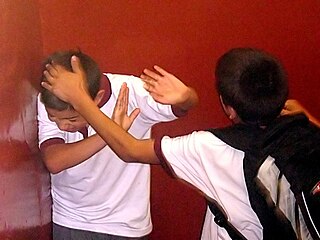Related Research Articles
Abuse is the improper usage or treatment of a thing, often to unfairly or improperly gain benefit. Abuse can come in many forms, such as: physical or verbal maltreatment, injury, assault, violation, rape, unjust practices, crimes, or other types of aggression. To these descriptions, one can also add the Kantian notion of the wrongness of using another human being as means to an end rather than as ends in themselves. Some sources describe abuse as "socially constructed", which means there may be more or less recognition of the suffering of a victim at different times and societies.

Bullying is the use of force, coercion, hurtful teasing or threat, to abuse, aggressively dominate or intimidate. The behavior is often repeated and habitual. One essential prerequisite is the perception of an imbalance of physical or social power. This imbalance distinguishes bullying from conflict. Bullying is a subcategory of aggressive behavior characterized by hostile intent, imbalance of power and repetition over a period of time.
School violence includes violence between school students as well as attacks by students on school staff. It encompasses physical violence, including student-on-student fighting, corporal punishment; psychological violence such as verbal abuse, and sexual violence, including rape and sexual harassment. It includes many forms of bullying and carrying weapons in school. The one or more perpetrators typically have more physical, social, and/or psychological power than the victim. It is widely believed by society to have become a serious problem in recent decades in many countries, especially where weapons such as guns or knives are involved.
Workplace bullying is a persistent pattern of mistreatment from others in the workplace that causes either physical or emotional harm. It can include such tactics as verbal, nonverbal, psychological, and physical abuse, as well as humiliation. This type of workplace aggression is particularly difficult because, unlike the typical school bully, workplace bullies often operate within the established rules and policies of their organization and their society. In the majority of cases, bullying in the workplace is reported as having been done by someone who has authority over the victim. However, bullies can also be peers, and rarely subordinates.
Sexual harassment in education in the United States is an unwelcome behavior of a sexual nature that interferes with an American student's ability to learn, study, work or participate in school activities. It is common in middle and high schools in the United States. Sexual or gender harassment is a form of discrimination under Title IX of the Education Amendments of 1972. Sexual harassment involves a range of behavior from mild annoyances to unwanted touching and, in extreme cases, rape or other sexual assault.
Internet safety, also known as online safety, cyber safety and electronic safety (e-safety), is the act of maximizing a user's awareness of personal safety and security risks to private information and property associated with using the Internet, and the self-protection from computer crime.

School bullying, like bullying outside the school context, refers to one or more perpetrators who have greater physical strength or more social power than their victim and who repeatedly act aggressively toward their victim. Bullying can be verbal or physical. Bullying, with its ongoing character, is distinct from one-off types of peer conflict. Different types of school bullying include ongoing physical, emotional, and/or verbal aggression. Cyberbullying and sexual bullying are also types of bullying. Bullying even exists in higher education. There are warning signs that suggest that a child is being bullied, a child is acting as a bully, or a child has witnessed bullying at school.
Disability abuse is when a person with a disability is abused physically, financially, sexually and/or psychologically due to the person having a disability. This type of abuse has also been considered a hate crime. The abuse is not limited to those who are visibly disabled or physically deformed, but also includes those with learning, intellectual and developmental disabilities or mental illnesses.
Mobile harassment refers to the act of sending any type of text message, sext, photo message, video message, or voicemail from a mobile phone that causes the receiver to feel harassed, threatened, tormented, humiliated, embarrassed or otherwise victimized. It is recognized as a form of cyberbullying.

Researchers study Social media and suicide to find if a correlation exists between the two. Some research has shown that there may be a correlation.

Sexual bullying is a form of bullying or harassment in connection with a person's sex, body, sexual orientation or with sexual activity. It can be physical, verbal or emotional in nature, and occurs in various settings, including schools, workplaces, and online platforms. Sexual bullying can have serious and lasting effects on the mental and emotional well-being of victims.
Bullying and suicide are considered together when the cause of suicide is attributable to the victim having been bullied, either in person or via social media. Writers Neil Marr and Tim Field wrote about it in their 2001 book Bullycide: Death at Playtime.
Workplace harassment is the belittling or threatening behavior directed at an individual worker or a group of workers.
Cyberstalking and cyberbullying are relatively new phenomena, but that does not mean that crimes committed through the network are not punishable under legislation drafted for that purpose. Although there are often existing laws that prohibit stalking or harassment in a general sense, legislators sometimes believe that such laws are inadequate or do not go far enough, and thus bring forward new legislation to address this perceived shortcoming. In the United States, for example, nearly every state has laws that address cyberstalking, cyberbullying, or both.
Campus sexual assault is the sexual assault, including rape, of a student while attending an institution of higher learning, such as a college or university. The victims of such assaults are more likely to be female, but any gender can be victimized. Estimates of sexual assault, which vary based on definitions and methodology, generally find that somewhere between 19 and 27% of college women and 6–8% of college men are sexually assaulted during their time in college.
Bullying in academia is a form of workplace bullying which takes place at institutions of higher education, such as colleges and universities in a wide range of actions. It is believed to be common, although has not received as much attention from researchers as bullying in some other contexts. Academia is highly competitive and has a well defined hierarchy, with junior staff being particularly vulnerable. Although most universities have policies on workplace bullying, individual campuses develop and implement their own protocols. This often leaves victims with no recourse.
Cyberbullying or cyberharassment is a form of bullying or harassment using electronic means. Cyberbullying and cyberharassment are also known as online bullying. It has become increasingly common, especially among teenagers and adolescents, due to the communication technology advancements and young people's increased use of such technologies. Cyberbullying is when someone, typically a teenager, bullies or harasses others on the internet and other digital spaces, particularly on social media sites.
College dating is the set of behaviors and phenomena centered on the seeking out and the maintenance of romantic relationships in a university setting. It has unique properties that only occur, or occur most frequently, in a campus setting. Such phenomena as hooking up and lavaliering are widely prominent among university and college students. Hooking up is a worldwide phenomenon that involves two individuals having a sexual encounter without interest in commitment. Lavaliering is a "pre-engagement" engagement that is a tradition in the greek life of college campuses. Since fraternities and sororities do not occur much outside of the United States, this occurs, for the most part, only in the US. Technology allows college students to take part in unique ways of finding more partners through social networking. Sites such as Facebook, Twitter, and MySpace allow students to make new friends, and potentially find their spouse.
New York State's Dignity for All Students Act, also known as The Dignity Act, and most commonly referred to by its acronym, DASA, is legislation in the U.S. state of New York, established to provide a school environment free of discrimination and harassment. It was signed into law by former Governor David Paterson on September 13, 2010 but was not implemented in school districts statewide until July 1, 2012. This act was first introduced to the New York State Senate in 1999 by Senator Thomas Duane. "The Act to support student’s mental health at school and during school related events. It enforces a strict zero-tolerance policy for student discrimination, harassment, intimidation, taunting and bullying.
Online child abuse is a unique form of child abuse also known as “Cyber Molestation” due to its virtual, distanced, and anonymous nature. Such abuse may not happen face-to-face, nor does it necessarily require physical contact. However, online abuse can result in negative face-to-face consequences in the form of statutory rape, forcible sexual assault, harassment, etc. In the United States, online child abuse is recognized as a form of child abuse by the National Society for the Prevention of Cruelty to Children.
References
- ↑ Keashly L Faculty Experiences with Bullying in Higher Education Causes, Consequences, and Management - Administrative Theory & Praxis Volume 32, Number 1 March 2010
- ↑ "Bullying on College Campuses." Alberti Center for Bullying Abuse Prevention, n.d. Web. 26 Jan. 2014. <http://gse.buffalo.edu/gsefiles/documents/alberti/Bullying%20In%20College%20FAQ%20Final.pdf>
- 1 2 4. MacDonald, Christine D. "Cyberbullying among College Students: Prevalence and Demographic Differences." Cyberbullying among College Students: Prevalence and Demographic Differences. N.p., 2010. Web. 26 Mar. 2014.
- ↑ "Bullying in college: silent yet prevalent". USA TODAY. Retrieved 2023-07-17.
- ↑ Keashly, Loraleigh; Neuman, Joel H. (2010). "Faculty Experiences with Bullying in Higher Education". Administrative Theory & Praxis. 32: 48–70. doi:10.2753/ATP1084-1806320103. S2CID 142766958.
- ↑ Mahmoudi, Morteza (2020). "A survivor's guide to academic bullying". Nature Human Behaviour. 4 (11): 1091. doi:10.1038/s41562-020-00937-1. PMID 32868883. S2CID 221403792.
- ↑ 7. "FIPG Risk Management Policy" (PDF). Fraternal Information & Programming Group. July 2008. Retrieved 27 May 2009.
- ↑ 8. "RA Magazine.com | The Responsibility Issue | Bullying in College." RA Magazine.com | The Responsibility Issue | Bullying in College. N.p., n.d. Web. 01 Feb. 2014. <http://www.ramagazine.com/issue/11/bully.html>
- ↑ "cyberbullying - definition of cyberbullying in English | Oxford Dictionaries". Oxford Dictionaries | English. Archived from the original on November 16, 2016. Retrieved 2016-11-15.
- ↑ Jose Bolton; Stan Graeve (2005). No Room for Bullies: From the Classroom to Cyberspace. Boys Town Press. ISBN 978-1-889322-67-4. Retrieved 2013-10-29.
- ↑ Schnenk, Allison (2013). "Characteristics of College Cyberbullies". Computers in Human Behavior. 29 (6): 2320–2327. doi:10.1016/j.chb.2013.05.013.
- ↑ "James Roffee & Andrea Waling Rethinking microaggressions and anti-social behaviour against LGBTIQ+ Youth". Safer Communities. 15: 190–201. doi:10.1108/SC-02-2016-0004.
- 1 2 3 12. "NOBullying.com." No BullyingExpert Advice On Cyber Bullying School Bullying. N.p., n.d. Web. 09 Feb. 2014. <http://nobullying.com/bullying-in-college/ Archived 2014-05-17 at the Wayback Machine >
- 1 2 3 4 13. McDougall, Lynne,. "A Study of Bullying in Further Education." Pastoral Care (1999): 31-37. Web. 10 Feb. 2014.
- ↑ 14. "Prevention Update: Bullying and Cyberbullying at Colleges and Universities." The Higher Education Center for Alcohol, Drug Abuse, and Violence Prevention, n.d. Web. 03 Feb. 2014. <http://safesupportivelearning.ed.gov/sites/default/files/sssta/20130315_january2012.pdf>
- ↑ 15. "Michigan State University MSU Extension." Bullying Issues Continue into the College Years for Some Students. N.p., n.d. Web. 27 Jan. 2014. <http://msue.anr.msu.edu/news/bullying_issues_continue_into_the_college_years_for_some_students>
- ↑ 16. Prevention of Bullying in Schools, Colleges, and Universities. American Education Research Association, n.d. Web. 03 Feb. 2014. <http://www.bc.edu/content/dam/files/schools/lsoe/pdf/Newsitenms/Prevention%20of%20Bullying%20in%20Schools,%20Colleges%20and%20Universities.pdf>